In an excerpt from “Mantle of Blue – History of the Northeast Province Society of Mary 1924-1974” by Rev. Lionel F. Beaudoin, s.m., published in 1974, and used by permission from the Marist Fathers & Brothers of the United States, Boston, Mass., the following is a fairly detailed account of what went on behind the scenes before Notre Dame High School in Harper Woods was built and the roughly 20 years thereafter.
(from “Mantle of Blue – History of the Northeast Province Society of Mary 1924-1974” by Rev. Lionel F. Beaudoin, s.m. Published 1974)
© 1974 Marist Fathers of Boston, Inc.
A NEW HIGH SCHOOL ON THE EASTSIDE – THE FIRST 20 YEARS
Harper Woods, Michigan, is a relatively new little city tucked in between Detroit and Grosse Pointe Woods. It was Gratiot Township until 1951, when the voters decided to incorporate as a city. What has given Harper Woods added importance is the huge regional Shopping Center called “Eastland” that the J.L. Hudson Co. has built there at an estimated cost of $20,000,000. The center is situated in the northwest corner of Harper Woods at E. Eight Mile and Kelly roads. The city is a community of homes with only two building sites zoned for manufacturing. It is a prosperous and growing area with a population of 20,186. (1970 census)
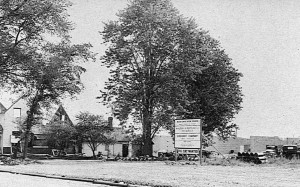
Shown above is the parcel of land in Harper Woods that was soon to become Notre Dame High School
During the intervening years, these concerned priests met often to discuss various phases of the problems, sometimes with the Cardinal, at other times among themselves. When it became evident that the Holy Cross Fathers could not undertake the project, other congregations were sought, until the Marists Fathers offered some hope in the matter.
The board of six pastors, anxious to have a fine school in the area, consisted of the following: Reverend Leo Huver, St. Veronica – president; Reverend Joseph Ording, St. Jude – vice-president; Reverend Joseph Schuler, Guardian Angels – secretary; Reverend John C. Jordan, St. Joan of Arc, St. Clair Shores – treasurer; Reverend Emil Capano, Our Lady, Queen of Peace; and Rt. Reverend Joseph Marx, Assumption Grotto.
A series of meetings was held, culminating in a private interview between Cardinal Mooney and Father Parent, Provincial. The year of 1953 was a time of decisions and happenings for the Marists in Detroit, Michigan. One of the first things on the agenda was to form a corporation entitled: “Marist Fathers of Detroit, Inc.” The articles of incorporation were drawn up, signed on February 9, 1953, and duly filed before the State of Michigan, through the Michigan Corporation and Securities Commission, Lansing, Michigan, on March 17, 1953. Bylaws for the new corporation were approved and signed on April 14, 1953.
Early in 1953, another vital document was agreed upon and signed:
MEMORANDUM OF AGREEMENT
Made by the pastors of the parishes covered.
1. The Marist Fathers agree to erect a high school for at least 750 boys and to expand these facilities as their finances permit.
2. The Marist Fathers will be given a free and clear deed to 15 acres of land for the purpose of erecting a high school.
3. They will be given the sum of $120,000 as needed, contributed by the parishes in equal proportions, as follows: St. Veronica, East Detroit $20,000; Guardian Angels $20,000; Assumption Grotto $20,000; Queen of Peace $20,000; St. Jude $20,000; St. Joan of Arc, St. Clair Shores $20,000.
4. The students of the above-named parishes will be given priority in admission to Notre Dame High School conducted by the Marist Fathers.
5. The proportion of new students allotted for each parish shall be equal each year for each parish.
6. The Marist Fathers agree that no other students from any other parishes will be admitted to the school until the above quotas are satisfied. In the event one parish does not fulfill its quota by May 1st of each year, the remaining openings are distributed among the other parishes according to the proportion agreed upon.
7. In addition to the gift of land and money, mentioned above, the parishes further agree to pay for the period of four years, the interest on the loan of $400,000, which is incurred by the Marist Fathers, to build the original building. The proportion for each parish is to be the same as the original contribution.
8. The Marist Fathers are allowed to retain the occupancy of the residence on Boston Boulevard for a period of seven years. This period may be prolonged by mutual agreement.
9. The tuition charge—exclusive of that for textbooks—will not exceed $100 per student per year. If revision of this charge becomes necessary, it will be enacted only after agreement with the pastors.
10. If any student with priority admission rights is unable to pay his tuition, the pastor of his parish will provide it, or the student will lose the priority.
(SIGNED) L. A. HUVER, pastor of St. Veronica, East Detroit
J. SCHULER, pastor of Guardian Angels
JOSEPH S. MARX, pastor of Assumption Grotto
EMIL A. CAPANO, pastor of Queen of Peace
J. J. ORDING, pastor of St. Jude
JOHN C. JORDAN, pastor of St. Joan of Arc
CHAS. P. DECKER, s.m., Marist representative
Approved by: (SIGNED) EDWARD CARD. MOONEY, Archbishop of Detroit.
It is an enormous undertaking to erect a modern high school, meeting all specifications and requirements of the complex programs essential to the educational development of our advanced times. An obvious and essential need is money. It was to obtain the necessary funds that a mortgage loan was made through The Northwestern Mutual Life Insurance Co. of Milwaukee, Wisconsin, by the services of Mr. S. C. Turner, loan agent of the Company in Detroit, Michigan.
Negotiations were long, complicated and exhaustive. Participating principals were:
– The Sacred Congregation of Religious, Vatican, Rome
– Very Rev. Alcime M. Cyr, s.m., Superior General, s.m., Rome
– Very Rev. Cyr J. Parent, s.m., outgoing Provincial, Boston Province
– Very Rev. James Lambert, s.m., newly-appointed Provincial
– Very Rev. Charles Decker, s.m., Superior of the Notre Dame Community
– Northwestern Mutual Life Insurance Co., Milwaukee, Wisconsin, by: Mr. S.
C. Turner, Mortgage Loan Regional Office, Detroit, Michigan, Mr. Stuart C.
Woodworth, Lyne, Woodworth & Evarts, Att., Boston, Mass
In petitioning the Holy See for approval to negotiate a loan, Very Rev. James Lambert, s.m., succinctly exposed the matter thusly:
“The Provincial Superior of the Boston Province of the Society of Mary (Marist Fathers), with Provincial House in the Archdiocese of Boston, incorporated as “The Marist Fathers of Boston, Incorporated,” requests permission of the Holy See to borrow $350,000 in order to build a high school for boys in the Archdiocese of Detroit (Michigan). It is proposed to borrow this sum from the Northwestern Mutual Insurance Company, Milwaukee, Wisconsin, as being the most reliable and as offering the best terms. The obligation will be secured by a mortgage on the proposed building and a mortgage on a property owned by the Marist Fathers in Framingham (Massachusetts) valued at $618,000 or a property owned by the Marist Fathers in Bedford (Massachusetts) valued at $335,000 according to the requirements of the loan agency when final arrangements are made. Interest on the loan, at current market rates (4-1/2% at present: this rate may vary approximately 1/2%) will be paid for the first four years by the six parishes served by the school; thereafter from current revenues of the Boston Province of the Society of Mary, including the revenue from the new school. An amortization fund will be established and maintained for the payment of the mortgage. Payments on the loan would be made quarterly over a period of twenty years.”
(Signed) JAMES LAMBERT, s.m., Provincial
Following the original loan of $350,000, the amount was increased to $835,000, September 19, 1955, to cover the cost of added facilities, and eventually amplified to $1,200,000 on June 15, 1965, when the new gymnasium and cafeteria additions were completed. The loan was made through the same Northwestern Mortgage Loan Regional Office in Detroit, and using the same mortgage arrangements.
It naturally devolved upon the Provincial of the Boston Province to obtain needed permissions, and upon the treasurers to keep a finger on the financial pulse of the Detroit project.
The official authorization came from the General House and was as follows:
OFFICIAL
28th of April 1953.
Feast of Blessed P.L. Chanel
My dear Father Parent:
This is to bring you the official authorization of the General Administration, to proceed in the realization of the project for the (East) Detroit High School as outlined in your communication of April 21, which gave the results arrived at, in the deliberations of the meeting of your Council held on that date, with Fr. Menard, the Provincial Treasurer, present. This decision was taken with the unanimous consent of the Council this morning.
We are very much pleased to note that the local parish priests have agreed to pay the interest on the initial loan for a period of four years. This is fine encouragement indeed. With this in mind, we see the great advantage to the Province in building now the added classroom space that is marked “for future expansion” on the preliminary floor plan, and more so, that the Archdiocesan School Authorities and the Local Superior and his Council in Detroit are all in favor of putting up all these sections at one time, thus saving considerable expenses that would be entailed later.
We hope that you will succeed in negotiating a loan at a fair rate of interest. The permission of the S. Congregation of Religious will be necessary to make this loan. Though you could obtain this permission from the Apostolic Delegate in Washington, D.C., I personally am of the opinion that it would be better for us to apply directly to the S. Congregation here, for you. However, I do not insist on this, for there may be new regulations in favor of religious congregations in the U.S.A., of which I am not aware, and which make it easier by applying to the Apostolic Delegation. In any case, we will want to be informed on the exact amount of the loan, the rate of interest, the terms for repayment of the capital, and the securities given.
With cordial greetings and prayerful best wishes, I am yours sincerely in Christo et Maria,
A. M. CYR, s.m., Sup. Gen.
GROUND IS BROKEN
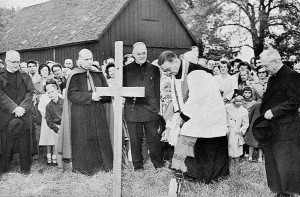
On October 4, 1953, Rt. Rev. Msgr. Henry E. Donnelly, head of the Eastern Deanery of the Detroit Archdiocese, breaks ground in Harper Woods to officially begin the construction of Notre Dame High School
Armed with the first vital loan, plans for the new school were drafted, and construction began with groundbreaking ceremonies on Sunday, October 4, 1953. Taking part in this official launching of the project were Rt. Rev. Msgr. Henry E. Donnelly, head of the Eastern Deanery of the Detroit Archdiocese; Rt. Rev. Msgr. Carroll F. Deady, Archdiocesan Superintendent of Schools; and Very Rev. James Lambert, s.m., Provincial of the Marist Fathers.
The following item appeared in the Michigan Catholic diocesan paper, October 1, 1953: “A regional Catholic High School to serve Northeast Detroit and suburban East Detroit, St. Clair Shores and Harper Woods will be launched with the breaking of ground Sunday at 3:00 p.m. at the site of Kelly Rd. near Eight Mile Rd. in Harper Woods.
“Details of the proposed new school, to be known as Notre Dame High, were announced Thursday, by Msgr. Carroll F. Deady, Archdiocesan Superintendent of Schools. The first unit, for 800 boys, will be ready for service next September. A companion unit for girls is planned for September 1955. The boys high school is a cooperative project of the Marist Fathers and six parishes: St. Veronica, East Detroit; Guardian Angels; Assumption Grotto; St. Jude; Queen of Peace, Harper Woods; and St. Joan of Arc, St. Clair Shores. It will enroll 200 students in the ninth grade next September, and add a grade each year until the full high school course is established.
“The school will be located on 15 acres. There will be 25 classrooms and cafeteria in the present unit. A large athletic stadium is part of the first unit, with a football field, baseball diamond, and track. The girls’ high school will occupy the 10 other acres of the 25-acre plot.
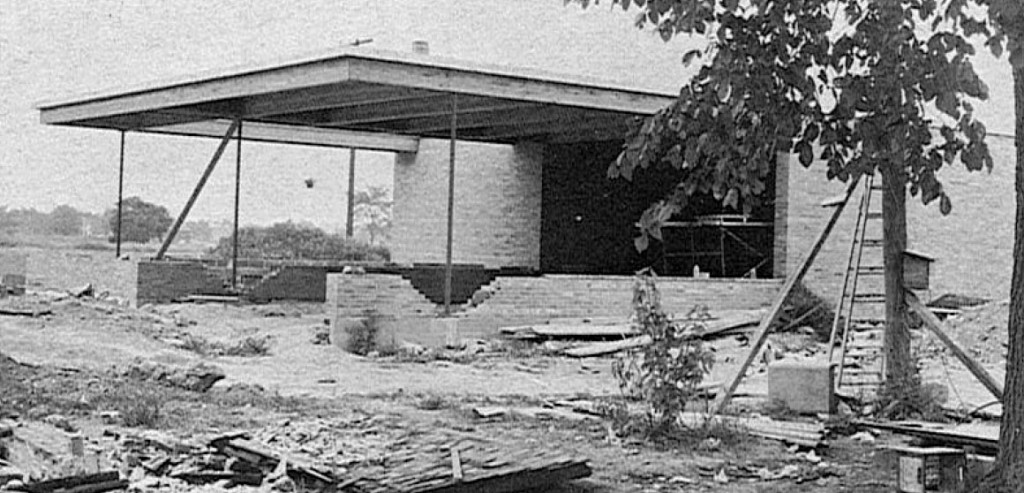
The front entrance of Notre Dame High School is shown during construction.
“Msgr. Henry E. Donnelly, dean of the eastern deanery, will officiate at Sunday’s groundbreaking. The speaker will be Very Rev. James Lambert, Provincial of the Marist Fathers and Rev. Charles Decker, representing the Marist Fathers who staff Cathedral Central High School here.”
The site chosen for Notre Dame High School was at 20254 Kelly Road, Harper Woods, just around the corner from Eight Mile Road and Eastland Shopping Center. The architect for the school was Mr. Walter J. Rozycki of Detroit, Michigan, and the contractor was the Krieghoff Co., General Builders, also of Detroit. There were adjustments and readjustments to the original plans (totaling $25,000), and fluctuations on the estimated costs, but construction began in the fall of 1953, and continued apace.
AND THE BOYS ROLLED IN
Notre Dame High School opened its doors to a freshman class for the first time on September 7, 1954. The following year, Regina High School, a new establishment for girls, was built adjacent to Notre Dame High, to complement the educational center at Harper Woods.
The first Marist staff at Notre Dame was: Rev. Austin E. Verow, s.m., Superior; Rev. Robert Graham, s.m., Vice-Superior; Rev. Robert Champagne, s.m.; Rev. Raymond Ouellette, s.m.; and Rev. James Kiley, s.m.
Living quarters for the Notre Dame Marist faculty became an acute problem that was temporarily solved by buying a house on Juliana St. nearby. As time went on, however, some fathers were obliged to live in several empty classrooms at the school, and then in apartments that were rented or bought outright.
In the Boston provincial circular letter dated Dec. 1, 1956, the following entry is found: “Notre Dame, Detroit, really has an eye-opener in its first yearbook, ‘The Juggler.’ On Sunday, Oct. 21, a record-breaking crowd of Notre Dame football fans was on hand to witness the dedication of the school’s new stadium, and the homecoming game of Notre Dame’s team.”
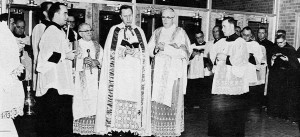
Aux. Bishop Alexander M. Zaleski, vicar general of the Archdiocese of Detroit, prays during the dedication of Notre Dame High School.
A milestone was passed on March 3, 1961, when accreditation was accorded Notre Dame High School by the University of Michigan, Ann Arbor, for a period of two years, 1961 to 1963. This was a prelude to accreditation by the State of Michigan, which came in the fall of 1961.
GYMNASIUM IN THE WORKS
The year 1964 marked another memorable milestone in the short history of Notre Dame High School. It seemed appropriate that the construction of the new gymnasium should coincide with the tenth anniversary of Notre Dame. A congratulatory message from the Very Rev. Marist Provincial, Austin E. Verow, s.m., said in part: “The culmination of this ‘dream come true’ is an achievement that must be deeply rewarding to everyone associated with Notre Dame in the years past and at the present time. . .”
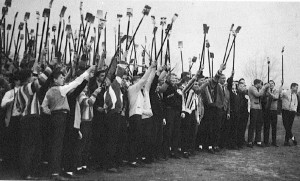
After the ground-breaking ceremonies at the start of construction for the new NDHS gymnasium, 250 students, who sold their quota of spring drive tickets, hold their shovels high for the news media.
The gymnasium was originally planned for 1958, and money was raised for the much-needed facility. It was only on April 29, 1964, however, that the digging of the foundation began, and the official dedication took place on November 1, 1964. The opening was finally held on February 18, 1965.
The groundbreaking ceremonies, “engineered” by the students of Notre Dame were mildly unusual. In place of a few dignitaries going through the traditional procedures and ritual, the Notre Dame hopefuls who had sold their quota of tickets in the Spring Fund Drive, were each given a spade. On a fired signal by Rev. James Kiley, s.m., principal of Notre Dame, 250 eager students struck their spades into the muddy earth and went at it with a vengeance! A caterpillar tractor then moved in to continue the spading, while the Notre Dame Band played several lively selections to help the work along.
In 1964, Notre Dame High School added a gymnasium and cafeteria facility, which was constructed by Donaldson & Meier, architects; Thomas J. Black, mechanical and electrical engineers; and Matthew Lalewicz, Inc., general contractor. The cafeteria extension also housed an enlarged locker room, shower room and an extra-long rifle range. The new construction was named the Notre Dame Memorial Gymnasium as a tribute to the sacrifices and generosity of the many friends of the school; it cost approximately $400,000.
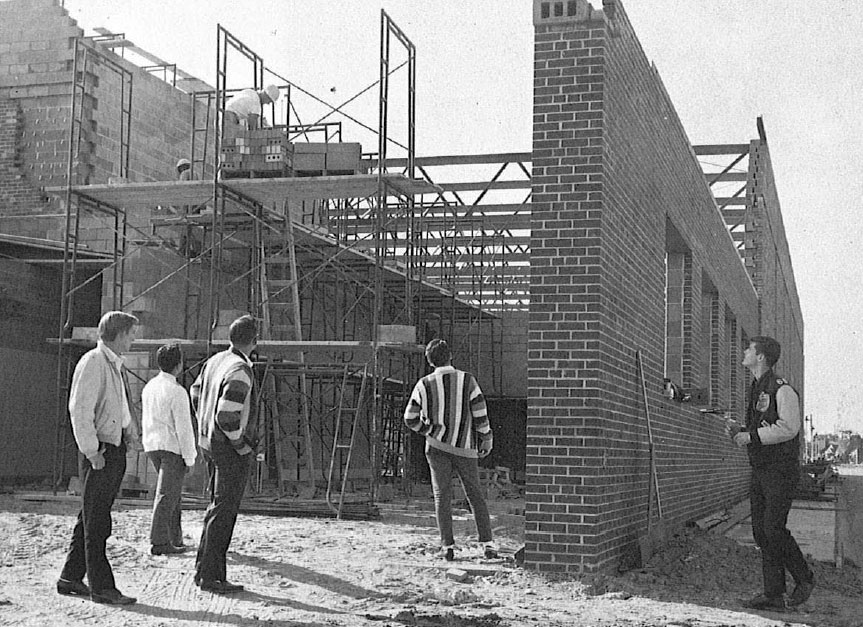
Students observe the ongoing construction of the new NDHS gymnasium in 1964
NEW RESIDENCE FOR THE MARISTS
The year 1965 was judged to be the year for the building of a residence for the Marist personnel. A commodious, modern and attractive building was planned and constructed by the Charles M. Valentine Associates, Inc., at a cost of approximately $250,000. The accommodations included 32 rooms, bedrooms with bath, chapel, dining room, kitchen, indoor and outdoor recreation areas (the outdoor swimming pool was a gratuitous gift from the builders), and a complete suite for the domestic staff. Construction of the Marist residence was done by Mr. Edward Wagonsomer, one of the associate builders from Detroit.

In 1964, construction of a residence for Marist fathers and brothers began on property just behind the NDHS gymnasium in Harper Woods. The area in between the two main wings would eventually hold an in-ground swimming pool that was donated by the builders.
With the completion of the Marist faculty residence, the building program at Notre Dame, Harper Woods, Michigan, came to an end. There remains the liquidation of the large debt, but the future is confronted with courage and with trust in Divine Providence.
Notre Dame High School boasts a completely modern educational facility. Built entirely on a ground-floor plan, it has all the required equipment and the comfortable classrooms needed to carry out an impressive program: theology, English, foreign languages, mathematics, sciences, social studies, physical education. Student activities list no less than 12 possibilities with art, music, dramatics, etc.; services are available in chapel, guidance, speech; and the athletic program takes in some ten different sporting events. There is a large library and a well-equipped laboratory. There is an alumni association, a mothers’ guild and a dads’ club, a dozen different students’ clubs, and a brass band that has consistently won awards in music competition. The religious program is evidently of top priority, with spiritual services and a vocation club that began in 1957.
GROWTH WAS SWIFT AND DRAMATIC
The development of Notre Dame High School has been rapid and satisfying. At the present time (1974) , the faculty numbers 48 and the student enrollment is about 1,000. The Marists who are members of the faculty are dedicated priests and religious, progressive and energetic. They deserve commendation for a task generously and expertly done in this vital and far-reaching apostolate.
As the years pass swiftly by, Notre Dame continues to be outstanding in its field: in its academic programs, its cultural and artistic endeavors, and its trophy-winning sports teams.
Notre Dame High School, Harper Woods, Michigan, gives all indications of vitality and social involvement. In its own words: “Notre Dame student policies aim at Christian formation, academic development, social consideration and dynamic citizenship…striving to promote a climate of personal growth, creativity, responsibility and freedom.”
Its motto is alive and promising: “Valor Virtusque” or “Courage and Virtue.”
(from “Mantle of Blue – History of the Northeast Province Society of Mary 1924-1974” by Rev. Lionel F. Beaudoin, s.m. Published 1974)
© 1974 Marist Fathers of Boston, Inc.
For a summary of the history of Notre Dame Preparatory School and Marist Academy in Pontiac, please click here.
